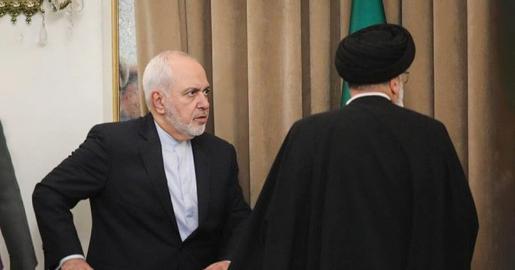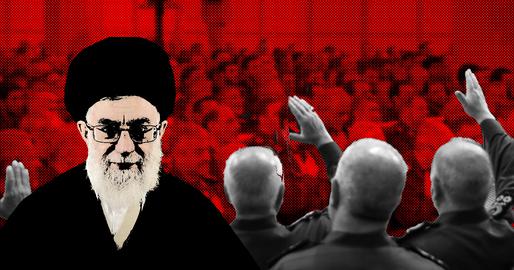A new online magazine that sets out to communicate the Supreme Leader’s views and directives directly to paramilitary and religious groups has met with fierce opposition from Iran’s most outspoken hardliners. Several prominent critics have questioned the authenticity of the new section of the site, saying it does not accurately represent Ayatollah Khamenei’s views.
The controversial publication, Hezbollah’s Line, is overseen and promoted by the office of Ayatollah Khamenei, and was launched to ensure that all the Supreme Leader’s directives and views are communicated directly to "revolutionary circles, Friday prayers leaders, religious boards and [the paramilitary] Basiji bases, without intermediaries”.
But some hardliners have accused people working in the office of abusing their positions, pushing their own political agendas, and misconstruing the Supreme Leader’s messages.
Khamenei announced the new publication, which can be downloaded from the Supreme Leader’s official website, in June, and seven issues of the four-page, two-color PDF have been produced so far, though the first three issues are currently not available.
It is not uncommon for the Supreme Leader’s official platform to offer such a service. A similar publication, Others, launched a decade ago, offered insight into Khamenei’s intentions and outlook through in-depth analysis of his speeches and official statements. Visuals from Others — including infographics and symbolic images — were used in smear campaigns against the 2009 Green Movement (referred to as “the Sedition”) and to set out arguments around the recent nuclear talks. And it was updated recently: In the days following the nuclear agreement in Vienna, Ali-Akbar Velayati, Khamenei’s advisor for international affairs, used this section of Khamenei’s website to issue guidelines to domestic media about how they should report on the event.
Nuclear negotiations and the deal have been focal points for Hezbollah’s Line too. Issue five of the magazine declared that red lines set out by Ayatollah Khamenei were not “land mines” that could be moved, but “tools” and “shields” to protect national interests. It advised hardliner activists to adopt a larger view when it came to the Vienna agreement, instead of issuing elaborate critiques of every aspect of the outcome, from sanctions relief to the specifics of uranium enrichment.
Hezbollah’s Line also appealed to readers to avoid comparisons of the nuclear deal with a famous compromise in the early history of Shia Islam. In doing so, the publication indirectly criticized President Hassan Rouhani, who was one of those to have drawn such comparisons. The tactic appears to have been successful, as Rouhani and his supporters have refrained from speaking in these terms in recent days.
Hardliners, on the other hand, were less malleable, and many reacted with anger and even desperation. One hardliner journalist, Mehdi Khanalizadeh, said Hezbollah’s Line’s advice amounted to “treason.” “They tell you that you must not talk technically and scientifically, you moron!” he wrote. “You must take the big view of the negotiations. It is a mistake to take your mastery of the English language, review the Joint Comprehensive Plan of Action and [UN Security Council] Resolution 2231 and show its legal problems, you stupid ass! You must wait to see what His Excellency Senior Advisor in International Affairs tells you.” Khanalizadeh said that the new section of the site had one clear message: “You must think the way that we tell you to think.”
“Some people abuse the positions given to them by the Supreme Leader to force their political views and goals on others,” Mohammad Reza Zahraei, a religious conservative activist from Qom, posted on Google+. “These strange statements and political spin on statements by the Supreme Leader can be answered by [the Leader’s] own statement in response to students who criticized the guidelines that had been interpreted by different people in different ways: “Thank God I can still talk. What I say takes precedence over what they say.’”
Don’t tear down the rampart
But Hezbollah Line definitely had its supporters. “Doubting the authenticity of the message issued by Khamenei.ir and its affiliated media can lead to internal divides and quarrels...which the enemy can take advantage of,” wrote Kamil Bagher Zadeh in response to growing criticism of the site’s new section. “Khamenei.ir is like a rampart only once removed from the Revolution’s Leader himself. Under present conditions, attacking Khamenei.ir is like bringing down this rampart.”
Bagher Zadeh’s conservative and religious credentials are solid. He is a clergyman, the son of prominent general and a longtime online activist. Even so, his support for Hezbollah Line did not make a noticeable dent in the wave of attacks. “Their team cannot even accept that somebody else uses the name Hezbollah’s Line for a video clip!” wrote one critic. “They called a site in the provinces and told them to change the name because they had a monopoly on it.”
Some pointed to errors that have appeared on the site previously. “It is the guardian who must preserve the sanctity of the shrine,” another religious conservative wrote. “Let us not forget that this same site published a text message by the Leader with just one word different from what he had said — but it completely changed the meaning. Of course that error was corrected, and hopefully this one will be set right as well.”
“The problem is that analyses by anonymous people are published in the name of the Supreme Leader,” another critic said. “You don’t think that the Leader personally checks each bit of content published on the site?”
Many complained that that the editorial managers of Khamenei.ir are not open to criticism, and implied that further websites might be set up to respond with the wave of misinformation sent out on behalf of the Supreme Leader. “If one is against their analysis and believes that the Leader sees it differently, what should one do?” someone asked. “Should he shut up or set up his own analysis site?”
Criticism of Hezbollah’s Line continues, but so far, the publication and its editors have failed to address most of the concerns put to them, apart from the occasional response to spelling and grammatical errors. It is most likely that this lack of attention is intentional, and meant to forestall a war of words that could lead to even deeper divisions across the hardliner camp. Certainly, the argument over the new content on Khamenei.ir exposes these rifts clearly. In recent months, Khamenei.ir has tried to ease differences by acting as a media command post, but now the site itself has been turned into a controversial, divisive, even “traitorous” space — and even, for some, an agent of “Sedition” and sinister dissent.
Related articles:
The Supreme Leader’s Supreme Nuclear Infographic (and what he really means)
Hardliners: “Nuclear Deal a False Victory”
To read more stories like this, sign up to our weekly email.
visit the accountability section
In this section of Iran Wire, you can contact the officials and launch your campaign for various problems
























comments